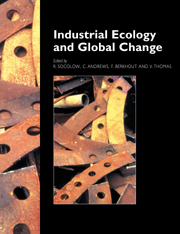Book contents
- Frontmatter
- Contents
- Foreword
- Preface
- Acknowledgments
- Contributors
- OVERVIEW
- PART 1 VULNERABILITY AND ADAPTATION
- PART 2 THE GRAND CYCLES: DISRUPTION AND REPAIR
- PART 3 TOXICS AND THE ENVIRONMENT
- 15 Introduction
- 16 Soil as a Vulnerable Environmental System
- 17 The Vulnerability of Biotic Diversity
- 18 Global Ecotoxicology: Management and Science
- 19 Industrial Activity and Metals Emissions
- 20 Metals Loading of the Environment: Cadmium in the Rhine Basin
- 21 Emissions and Exposure to Metals: Cadmium and Lead
- 22 Nuclear Power: An Industrial Ecology that Failed?
- PART 4 INDUSTRIAL ECOLOGY IN FIRMS
- PART 5 INDUSTRIAL ECOLOGY IN POLICY-MAKING
- END PIECE
- Organizing Committee Members
- Working Groups
- Index
18 - Global Ecotoxicology: Management and Science
Published online by Cambridge University Press: 04 August 2010
- Frontmatter
- Contents
- Foreword
- Preface
- Acknowledgments
- Contributors
- OVERVIEW
- PART 1 VULNERABILITY AND ADAPTATION
- PART 2 THE GRAND CYCLES: DISRUPTION AND REPAIR
- PART 3 TOXICS AND THE ENVIRONMENT
- 15 Introduction
- 16 Soil as a Vulnerable Environmental System
- 17 The Vulnerability of Biotic Diversity
- 18 Global Ecotoxicology: Management and Science
- 19 Industrial Activity and Metals Emissions
- 20 Metals Loading of the Environment: Cadmium in the Rhine Basin
- 21 Emissions and Exposure to Metals: Cadmium and Lead
- 22 Nuclear Power: An Industrial Ecology that Failed?
- PART 4 INDUSTRIAL ECOLOGY IN FIRMS
- PART 5 INDUSTRIAL ECOLOGY IN POLICY-MAKING
- END PIECE
- Organizing Committee Members
- Working Groups
- Index
Summary
Abstract
Global environmental pollution is here defined to include widespread, low-level increases in environmental concentrations of toxic substances; the net effects of a patchwork of regional pollution problems; and the increase in ultraviolet radiation (UV-B) due to decreases in stratospheric ozone. Current understanding of the effects of global pollution on ecosystems is poor, especially for low-level, widespread contamination by toxic substances. A research agenda is proposed to focus on understanding the sublethal effects of toxic substances, the mechanisms of tolerance and adaptation, the relationship of elevated tissue levels of pollutants to health consequences for the organism, and the behavior and effects of toxic substances in complex media, such as in sediments and soils.
Introduction
It is well known that toxic substances have the potential to harm ecological systems. However, the role of such substances as agents of global, rather than regional, change is poorly understood. Do toxic substances (and the practices that introduce them) simply cause a patchwork of regional insults, or do they harm the biosphere in ways that have profound global implications? Are subtle global impacts more important than acute but localized ones? Are the effects of toxic substances significant in comparison to effects attributable to other agents of global change? These questions cannot be answered in depth until advances are made in the science of ecotoxicology.
This chapter examines the most critical scientific barriers to answering the questions posed above. First, characteristics of global pollution are developed. Second, scientific questions that are vital for an understanding of both global and regional pollution problems are discussed and linkages described. Finally, priorities for global ecotoxicology are proposed.
- Type
- Chapter
- Information
- Industrial Ecology and Global Change , pp. 261 - 276Publisher: Cambridge University PressPrint publication year: 1994

